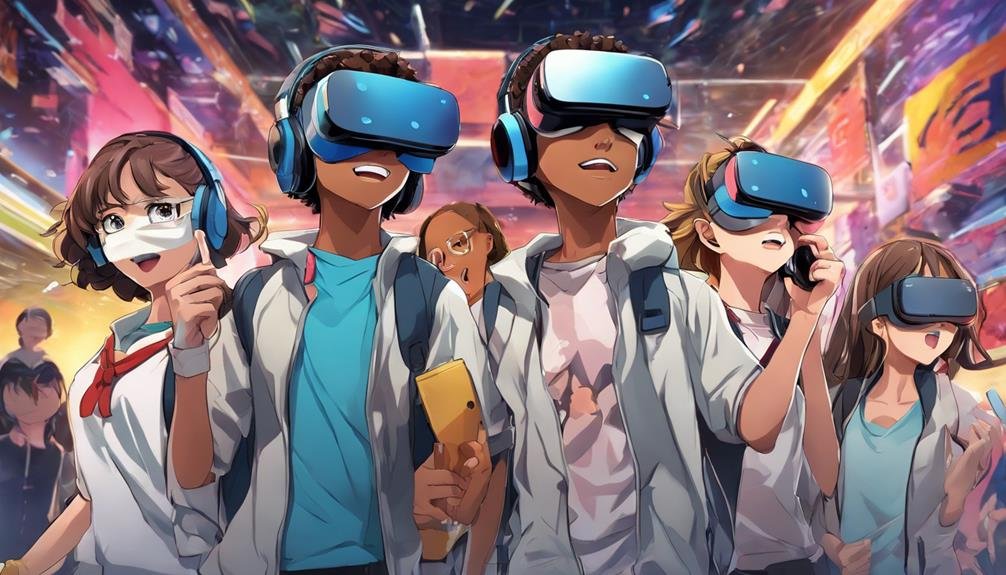How Can I Use Gamification to Enhance Learning Experiences?
Transform your learning journey with gamification's power. Boost engagement, tap into your competitive spirit, and feel accomplished. Integrate gamified assessments, enjoy interactive lessons, and immerse in virtual rewards. Create challenges, include rewarding systems, and explore creative quests. Break skills into levels, track progress, and offer milestone rewards. Ignite your passion, drive engagement, and foster competition. Experience the impact of gamification for yourself!
Key Takeaways
- Integrate gamified assessments to revolutionize learning experiences.
- Offer interactive lessons to boost student engagement.
- Create immersive learning experiences for increased retention.
- Provide virtual rewards to tap into natural competitive spirit.
- Simplify progress tracking to foster a sense of accomplishment.
Benefits of Gamification in Education
Discover the potential of gamification in education to revolutionize learning experiences and boost student engagement like never before. By incorporating game elements into educational activities, you can witness increased engagement and improved retention among your students.
Imagine transforming a mundane lesson into an interactive quest where students earn points for completing tasks or answering questions correctly. This gamified approach taps into the natural competitive spirit, motivating students to participate actively and aim for success. As they progress through levels or achieve milestones, their sense of accomplishment grows, leading to a deeper connection with the material being taught.
Furthermore, gamification provides immediate feedback, allowing students to learn from their mistakes and make corrections in real-time. This instant reinforcement reinforces positive behaviors and encourages continuous improvement. Through the use of leaderboards and rewards, you can create a dynamic learning environment that keeps students excited and enthusiastic to participate.
Embrace the power of gamification in education to transform your classroom into an engaging world of learning.
Implementing Gamified Learning Platforms
Ready to elevate your educational approach? Let's explore how to effectively integrate gamified learning platforms into your teaching strategies. Gamified assessments and interactive lessons are key components of these platforms, offering a dynamic way to engage students. By incorporating elements of gameplay into your lessons, you can create a more immersive learning experience that motivates and challenges learners.
One of the advantages of gamified learning platforms is the use of virtual rewards. These rewards act as incentives for students to progress and achieve their learning objectives. Whether it's accessing a new level, earning badges, or receiving points, virtual rewards keep students engaged and excited about their educational journey. Additionally, progress tracking is simplified through these platforms, allowing you to monitor individual performance and provide targeted support where needed.
Designing Engaging Gamification Activities
To create engaging gamification activities that enhance learning experiences, consider incorporating interactive challenges and rewards systems that keep students engaged and motivated. Interactive challenges can include puzzles, quizzes, or simulations that require active participation from the students. By presenting them with tasks that demand problem-solving and critical thinking, you can make the learning process more dynamic and enjoyable.
Integrating creative quests into your gamification activities can also be highly beneficial. These quests can involve storytelling elements, where students begin on adventures or missions related to the learning material. By immersing them in a narrative-driven experience, you can spark their curiosity and make the content more memorable.
Furthermore, incorporating a rewards system that offers incentives for completing challenges or reaching milestones can further enhance engagement. Whether it's earning points, badges, or revealing new levels, providing tangible rewards can motivate students to stay committed to their learning journey. By designing gamification activities that are interactive, creative, and rewarding, you can create a stimulating learning environment that fosters growth and knowledge acquisition.
Using Gamification for Skill Development
Enhance your skill development through the strategic implementation of gamification techniques that actively engage and motivate your learning journey. When it comes to skill improvement, incorporating interactive challenges through gamification can make the process both enjoyable and effective. Here's how you can use gamification for skill development:
- Skill-Based Levels: Break down the skill you want to develop into different levels, each representing a new challenge or milestone to overcome.
- Progress Tracking: Implement progress bars or visual indicators to show how far you've come and what still lies ahead, keeping you motivated.
- Rewards System: Offer virtual rewards such as badges, points, or virtual goods for completing tasks or achieving certain skill milestones.
- Time Challenges: Set time limits for completing tasks or challenges to enhance focus and quick decision-making skills.
Gamification Strategies for Student Motivation
Begin a journey of student motivation through the innovative application of gamification strategies that ignite learning passion and drive engagement in educational settings. Student engagement and motivation are essential elements in creating a dynamic learning environment. By incorporating interactive learning experiences and rewards within gamified activities, you can inspire students to actively participate and stay motivated throughout their educational journey.
One effective strategy is to introduce game-like elements such as points, badges, or levels to make learning more interactive and enjoyable. These rewards act as incentives, encouraging students to complete tasks and achieve learning objectives. Additionally, incorporating competition among peers or setting personal goals can further boost motivation levels and make the learning process exciting.
Furthermore, offering immediate feedback and celebrating achievements can reinforce positive behaviors and enhance student engagement. By integrating gamification into educational practices, you can create a stimulating learning environment that fosters motivation, collaboration, and a passion for acquiring knowledge.
Measuring the Impact of Gamification
Measuring the impact of gamification allows educators to quantitatively assess the effectiveness of incorporating game-like elements in learning environments. Impact assessment and data analysis are essential components in determining the success of gamification strategies.
Here are four key points to keep in mind when measuring the impact of gamification:
- Define Clear Objectives: Clearly outline what outcomes you expect to achieve through gamification to have a solid foundation for impact assessment.
- Collect Relevant Data: Gather data on student engagement, performance, and behavior to analyze the impact of gamification accurately.
- Utilize Analytics Tools: Use various analytics tools to track and measure the data collected, providing valuable insights into the effectiveness of gamification.
- Compare Results: Compare the data before and after implementing gamification to evaluate the impact on learning outcomes and student motivation effectively.
Conclusion
To sum up, by integrating gamification into learning experiences, you can transform the ordinary into the extraordinary.
Keep in mind, 'practice makes perfect,' and with gamified activities, students can practice and enhance their skills in an engaging and motivating way.
So, don't hesitate to harness the power of gamification in education to create a dynamic and effective learning environment that will inspire and empower learners to reach their full potential.







